Asphalt Mixture Testing Capabilities
Asphalt Mixture Testing Capabilities
Asphalt Mixture Testing Capabilities
See all of our available options below.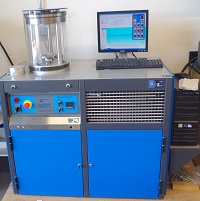
Asphalt Mixture Performance Tester (AMPT)
The Asphalt Mixture Performance Tester (AMPT) is typically used to conduct a variety of tests to characterize the performance of asphalt mixtures. Due to the ability of the AMPT to apply cyclic loading over a range of temperatures and frequencies, it is typically used to perform asphalt mixtures tests that include: (a) Dynamic Modulus (E*) determination for asphalt mixtures, (b) Texas Overlay (OT) test according to Tex-248 or other standards, (c) Semi-Circular Bend (SCB) testing to characterize fatigue cracking of asphalt mixtures, and (e) Flow Number (FN) and Flow Time (FT) to characterize rutting of asphalt mixtures.
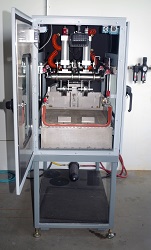
Asphalt Pavement Analyzer (APA)
The Asphalt Pavement Analyzer (APA) is used to characterize the rutting potential of asphalt mixtures at varying temperatures. Typically, this test is conducted according to AASHTO TP 63 “Determining Rutting Susceptibility of Asphalt Paving Mixtures Using the Asphalt Pavement Analyzer (APA).” The APA is one of the most popular laboratory wheel-tracking devices. The basic concept behind its operation is the application of wheel loading on top of a sample; simulating real-life conditions. To apply the load, a steel wheel can be used (similar to the Hamburg Wheel Tracking Device) directly on top of the asphalt sample or top of a pressurized hose (simulating tires). The APA is capable of controlling testing temperatures within its environmental chamber and can be used to test submerged samples.
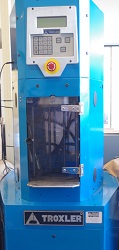
Superpave Gyratory Compactor (SGC)
The Superpave Gyrator Compactor (SGC) is used to compact Hot Mix Asphalt (HMA) mixture simulating field compaction using road rollers. The machine applies certain pressure to the HMA mix compacted using specially designed molds The pressure is applied in gyration motion in order to simulate actual road compaction conducted using rollers. Different gyration angles can be used to compact the sample. Two modes of compactions are typically used when compacting samples using the SGC: (a) compaction to a specific sample height and (b) compaction to a specific number of gyrations. The SGC also has the ability to record data regarding sample height at every gyration applied.
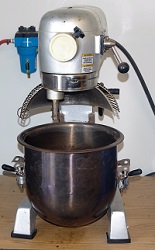
Asphalt Mixer
Hot Mix Asphalt (HMA) mixer is used to mix aggregates and asphalt binder to prepare asphalt mixtures. The mixer spreads an even layer of binder on each aggregate. All laboratory mixture test on HMA requires this mixer in order to prepare the laboratory specimens for testing. The heated aggregates are poured in the mixer and a measured amount of asphalt binder is added in the aggregate blend. The mixer is run at a certain mixing speed and for a specific mixing time using an appropriate mixing spindle. The mixture is prepared and poured in asphalt mixture trays to be placed in oven for further mix preparation.
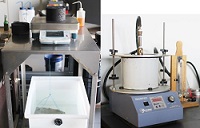
Asphalt Mixture Specific Gravities (Max. and Bulk Specific Gravities)
CREATE’S resources include a Vibro Deairator SGA-5R which is used in completing AASHTO T209 “Theoretical Maximum Specific Gravity and Density of Bituminous Paving Mixtures.” Through this test, the theoretical maximum specific gravity (assuming no voids within the mix) of an asphalt mixture determined. The Vibro Deairator SGA-5R is used to shake a loose asphalt mixtures sample submerged in water while at the same time applying vacuum into the sample and extracting all air bubble out. CREATE’s resources also include a water bath-scale assembly. This assembly is typically used to conduct determine the bulk specific gravity of compacted asphalt mix samples according to AASHTO T166 “Bulk Specific Gravity of Compacted Bituminous Mixtures Using Saturated Surface-Dry Specimens.” Dry sample weight and weight in water can be measured using this assembly.